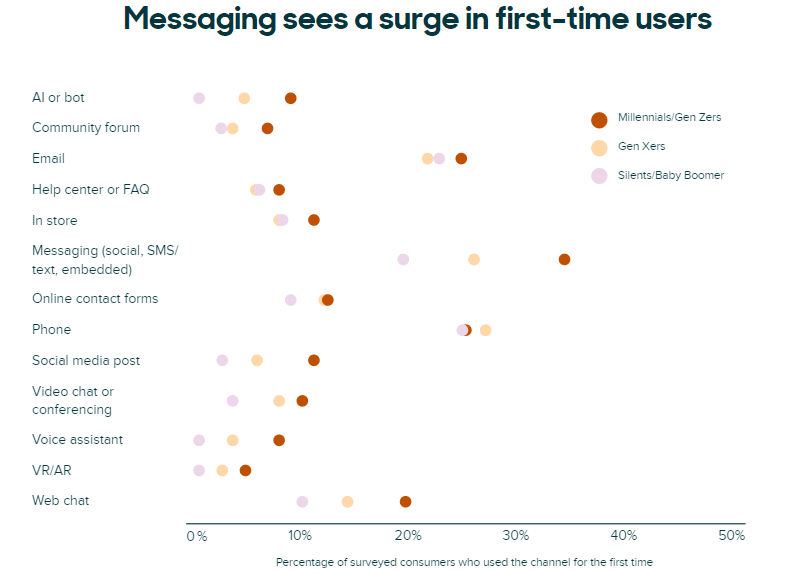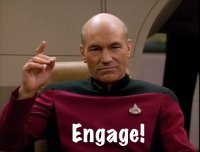Zendesk, Winterberry Group and Braze on the crucial role messaging plays in decisioning and orchestration.
Businesses used to get by with fixed and predictable storefronts, whether physical or digital. Advances in personalization can revitalize the digital experience, but even this isn’t enough. Many customers also expect two-way interaction with a brand through messaging or online chat.
These customer expectations are dynamic, so it’s useful to see how marketers are responding. How marketers respond, in turn, creates new customer expectations. The process is a give-and-take. It’s like a conversation.
What customers want from messaging
More customers are using messaging channels to engage with brands and make purchases. This is evident in the number of first-time users who adopted a messaging channel in the last year.
CRM software producer Zendesk recently studied the wide-ranging adoption of messaging, which extends across all age demographics. Among those surveyed, Zendesk found that in 2020 almost 40% of millennials and Gen Xers used messaging (on social, text or embedded in an owned channel) for the very first time to connect with a brand. Just under 30% of the same age group used phone for the first time, which gives an idea of how conversations are growing across many channels old and new. Twenty percent of baby boomers and older were also getting on the bandwagon with messaging as first-time users.
According to Jon Aniano, SVP of product at Zendesk, customers were already taking up messaging en masse before the pandemic. But as with other changes in everyday life, the pandemic accelerated this shift.

“What happened was that as people were stuck in their homes, this increased the volume of messaging with friends and family,” Aniano explained. “There were fewer face-to-face interactions, and people were on Zoom calls all day for work.” Facebook’s WhatsApp hit two billion users last year and demand has also increased for encrypted messaging apps like Signal and Telegram.
“While I think the pandemic has accelerated the trend, it’s always been there,” Aniano stated. “Now we’re well past the point of no return in terms of this trend.”
So customers expect brands to meet them where they are, through messaging channels. But Aniano also said that customers have a sophisticated understanding of automation that marketers can use to keep up with the proliferation of messaging. Customers expect automation for common questions that don’t require a lot of hand-holding.
“Consumers are beginning to expect some automation when chatting with a brand,” Aniano said. He added that businesses can develop rich messaging capabilities with video or voice, but the trick is to have robust data centers to inform these experiences.
Managing messaging data
Messaging is an important slice of overall customer engagement. It’s also a valuable source of customer data. The CRM can be seen by some marketing teams as the source of truth. But we’ve also shared why the CRM might cease to be the center of the universe.
According to Michael Harrison, managing director at analyst firm Winterberry Group, data from a lot of customer engagement is unstructured and needs to be integrated into the data layer by some additional tool or process. This unstructured data includes customer service, social discussions, reviews and live chat, among other channels. He added that advances in natural language processing are also pulling insights from voice channels that used to be merely qualitative.
“Once the unstructured data is standardized, brands can create unified customer profiles to power customer experience beyond marketing use cases,” Harrison said.
Once unified, all the data can be activated through coordinated decisioning and orchestration.
“Data flow is continuous between the channels, the applications, and the centralized decisioning layer, enabling a holistic view of a brand’s interactions with each customer,” Harrison explained. “Structurally, decisioning should span all customer-facing departments and be leveraged to solve for use cases across marketing, advertising, customer service and operations.”
In practice, where are marketers taking the insights that activate decisioning in the application layer? Winterberry Group (in research led by Harrison) found that segmentation solutions were most popular, used by 92% of respondents. Predictive modeling (73%), personalization (64%), omnichannel orchestration (64%), machine learning and AI (54%) and content optimization (42%) followed.
“At the most mature level (of brands), Winterberry Group finds centralized decisioning functions that seek to inform communication and messaging to enhance the customer experience across all touchpoints at any given moment,” Harrison stated.
Measuring messaging success
Assuming your brand has a broad decisioning and orchestration strategy in place, there is still one elusive barrier to overcome — metrics. Organizations have to agree internally on measures of success.
Customer engagement platform Braze found that while most marketers (88%) think their engagement strategy is excellent or good, 74% worry about how these metrics translate into business outcomes.
If teams are looking for common ground to agree on, they should look longer term.
Myles Kleeger, President and Chief Customer Officer at Braze, said, “Too many companies are still focused on top-of-funnel metrics like opens and clicks, as opposed to what really matters most — loyalty and long-term customer lifetime value.” Those factors depend on building relationships, which in turn depends for many of today’s customers on two-way interactions.
According to Kleeger, businesses need a company-wide definition of success that is then mapped onto each department and individual KPIs. Then, a holistic methodology is implemented to measure both near-term and long-term effects on customer behavior and business results.
“Finally,” Kleeger stated, “you must ensure that you are capturing the right metrics across each department that interacts with customers to understand how your teams and your programs are performing, both independently and more importantly, in aggregate.”
Based on growing engagement in messaging, and customers’ willingness to engage with brands through these channels, a compelling case can be made by marketers that messaging is crucial to both near and long-term goals.
Marketing Land – Internet Marketing News, Strategies & Tips
(171)








